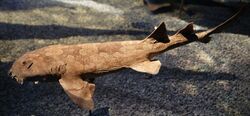Biology:Japanese wobbegong
From HandWiki
Short description: Species of shark
| Japanese wobbegong | |
|---|---|

| |
| Orectolobus japonicus in the Naturhistorisches Museum Wien | |
| Scientific classification | |
| Domain: | Eukaryota |
| Kingdom: | Animalia |
| Phylum: | Chordata |
| Class: | Chondrichthyes |
| Subclass: | Elasmobranchii |
| Subdivision: | Selachimorpha |
| Order: | Orectolobiformes |
| Family: | Orectolobidae |
| Genus: | Orectolobus |
| Species: | O. japonicus
|
| Binomial name | |
| Orectolobus japonicus Regan, 1906
| |

| |
| Range of Japanese wobbegong (in blue) | |
The Japanese wobbegong (Orectolobus japonicus) is a carpet shark in the family Orectolobidae of the wobbegong family, found in the tropical western Pacific Ocean from Japan and Korea to Viet Nam and the Philippines , between latitudes 43 and 6°N. It reaches a length of 1 m. Japanese wobbegong sharks typically remain motionless during the daytime, and are not active hunters. They use camouflage and their electroreceptor pores on their dorsal area to help them sense prey nearby.
See also
- List of sharks
References
- ↑ Rigby, C.L.; Bin Ali, A.; Bineesh, K.K.; Chen, X.; Derrick, D.; Dharmadi, Ebert, D.A.; Fahmi, Fernando, D.; Gautama, D.A. et al. (2020). "Orectolobus japonicus". IUCN Red List of Threatened Species 2020: e.T161563A124507360. doi:10.2305/IUCN.UK.2020-3.RLTS.T161563A124507360.en. https://www.iucnredlist.org/species/161563/124507360. Retrieved 19 November 2021.
- Froese, Rainer and Pauly, Daniel, eds. (2006). "Orectolobus japonicus" in FishBase. may 2006 version.
- Theiss, S. M., Collin, S. P. & Hart, N. S. Morphology and distribution of the ampullary electroreceptors in wobbegong sharks: implications for feeding behaviour. Mar Biol 158, 723–735 (2011).
Wikidata ☰ Q31794 entry
 |


